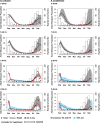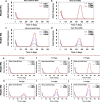A trade-off between dry season survival longevity and wet season high net reproduction can explain the persistence of Anopheles mosquitoes
- PMID: 30390714
- PMCID: PMC6215619
- DOI: 10.1186/s13071-018-3158-0
A trade-off between dry season survival longevity and wet season high net reproduction can explain the persistence of Anopheles mosquitoes
Abstract
Background: Plasmodium falciparum malaria remains a leading cause of death in tropical regions of the world. Despite efforts to reduce transmission, rebounds associated with the persistence of malaria vectors have remained a major impediment to local elimination. One area that remains poorly understood is how Anopheles populations survive long dry seasons to re-emerge following the onset of the rains.
Methods: We developed a suite of mathematical models to explore the impact of different dry-season mosquito survival strategies on the dynamics of vector populations. We fitted these models to an Anopheles population data set from Mali to estimate the model parameters and evaluate whether incorporating aestivation improved the fit of the model to the observed seasonal dynamics. We used the fitted models to explore the impact of intervention strategies that target aestivating mosquitoes in addition to targeting active mosquitoes and larvae.
Results: Including aestivation in the model significantly improved our ability to reproduce the observed seasonal dynamics of vector populations as judged by the deviance information criterion (DIC). Furthermore, such a model resulted in more biologically plausible active mosquito survival times (for A. coluzzii median wet season survival time of 10.9 days, 95% credible interval (CrI): 10.0-14.5 days in a model with aestivation versus 38.1 days, 95% CrI: 35.8-42.5 days in a model without aestivation; similar patterns were observed for A. arabiensis). Aestivation also generated enhanced persistence of the vector population over a wider range of both survival times and fecundity levels. Adding vector control interventions that target the aestivating mosquito population is shown to have the potential to enhance the impact of existing vector control.
Conclusions: Dry season survival attributes appear to drive vector population persistence and therefore have implications for vector control. Further research is therefore needed to better understand these mechanisms and to evaluate the additional benefit of vector control strategies that specifically target dormant mosquitoes.
Keywords: Aestivation; Anopheles mosquitoes; Mathematical modelling; Persistence; Plasmodium falciparum; Vector ecology.
Conflict of interest statement
Ethics approval and consent to participate
Not applicable.
Consent for publication
Not applicable.
Competing interests
The authors declare that they have no competing interests.
Publisher’s Note
Springer Nature remains neutral with regard to jurisdictional claims in published maps and institutional affiliations.
Figures





References
-
- WHO . World malaria report. Geneva: World Health Organization; 2015.
-
- WHO . World malaria report. Geneva: World Health Organization; 2014.

